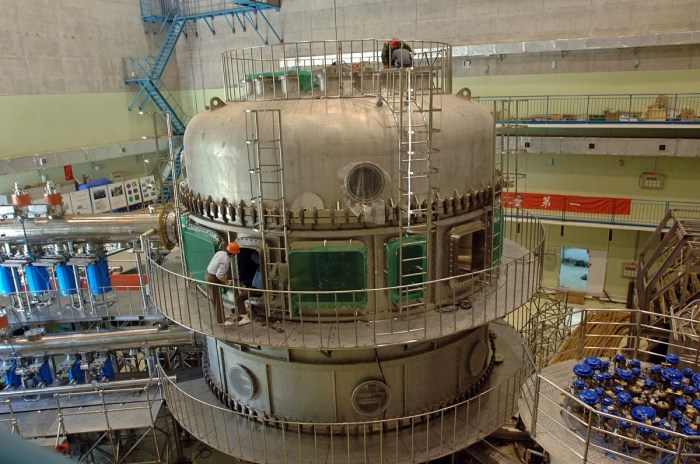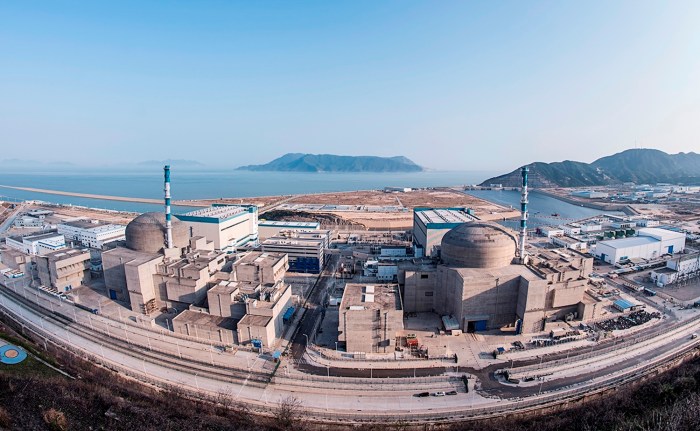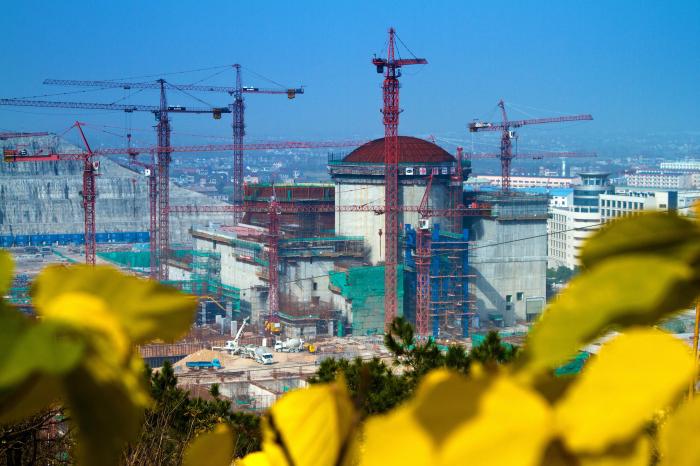Chinese nuclear reactor – China’s nuclear reactor program is a testament to the country’s commitment to clean energy and technological advancement. With a diverse fleet of reactors and ambitious plans for the future, China is poised to play a leading role in the global nuclear energy landscape.
From the early days of nuclear power in China to the latest advancements in reactor design, this article delves into the intricacies of China’s nuclear reactor program, exploring its significance, types, construction, fuel cycle, environmental impact, international collaborations, and future prospects.
Introduction
Nuclear reactors play a significant role in China’s energy sector, providing a substantial portion of the country’s electricity. China’s nuclear power industry has grown rapidly in recent years, making it one of the leading countries in nuclear power generation.
China’s nuclear power industry is driven by several factors, including the country’s growing energy demand, its commitment to reducing carbon emissions, and its desire to enhance its energy security.
China’s Nuclear Power Capacity, Chinese nuclear reactor
China has a large and growing nuclear power capacity. As of 2022, China has 53 operating nuclear reactors with a total installed capacity of approximately 55 gigawatts (GW). This makes China the third-largest nuclear power producer in the world, behind the United States and France.
China is also actively constructing new nuclear reactors. In 2022, China had 23 nuclear reactors under construction, with a total capacity of approximately 26 GW. Once these reactors are completed, China’s nuclear power capacity will increase significantly.
Types of Chinese Nuclear Reactors

China has a diverse range of nuclear reactors in operation, each with its unique design and capabilities. These reactors can be broadly classified into three main types: pressurized water reactors (PWRs), boiling water reactors (BWRs), and heavy water reactors (HWRs).PWRs are the most common type of nuclear reactor in China, accounting for the majority of the country’s nuclear power generation capacity.
PWRs use ordinary water as both the coolant and the moderator, which slows down neutrons to make them more likely to interact with uranium fuel. PWRs operate at high pressure, which helps to prevent the water from boiling and turning into steam.BWRs are similar to PWRs, but they use boiling water as the coolant.
This eliminates the need for a separate steam generator, which makes BWRs more compact and efficient than PWRs. However, BWRs are also more susceptible to corrosion and other problems associated with boiling water.HWRs use heavy water (deuterium oxide) as both the coolant and the moderator.
Heavy water is less efficient at slowing down neutrons than ordinary water, but it also absorbs fewer neutrons, which makes HWRs more efficient at producing plutonium. HWRs are typically used for research and development purposes, but they have also been used to produce electricity in some countries.The following table compares the key specifications of the different types of Chinese nuclear reactors:| Reactor Type | Coolant | Moderator | Fuel | Thermal Power (MW) | Electrical Power (MW) ||—|—|—|—|—|—|| Pressurized Water Reactor (PWR) | Ordinary water | Ordinary water | Uranium dioxide | 2,900 | 1,000 || Boiling Water Reactor (BWR) | Boiling water | Boiling water | Uranium dioxide | 3,000 | 1,100 || Heavy Water Reactor (HWR) | Heavy water | Heavy water | Uranium dioxide | 1,000 | 300 |
Construction and Operation of Chinese Nuclear Reactors
China has made significant progress in constructing and operating nuclear reactors, establishing a robust and comprehensive system that ensures safety and efficiency. The construction process involves meticulous planning, rigorous safety protocols, and advanced engineering techniques.
Once operational, nuclear power plants undergo stringent monitoring and maintenance to guarantee uninterrupted power generation and minimize environmental impact. China’s commitment to nuclear safety is reflected in its adherence to international standards and the implementation of comprehensive regulations.
Safety Measures and Regulations
China’s nuclear safety framework is guided by stringent regulations and international best practices. The country has established a robust regulatory body responsible for overseeing the entire nuclear power industry, from reactor design to waste management.
Nuclear power plants in China are equipped with multiple layers of safety systems, including containment structures, emergency cooling systems, and backup power supplies. These systems are designed to prevent and mitigate potential accidents, ensuring the safety of the public and the environment.
Case Studies of Successful Nuclear Power Plant Projects
China has successfully constructed and operated numerous nuclear power plants, showcasing its technological prowess and commitment to clean energy. Some notable projects include:
- Tianwan Nuclear Power Plant:Located in Jiangsu province, Tianwan is China’s first nuclear power plant to utilize foreign technology. It has been operating safely and efficiently since 2007.
- Qinshan Nuclear Power Plant:Situated in Zhejiang province, Qinshan is China’s first domestically designed and constructed nuclear power plant. It has been in operation since 1994 and has played a significant role in China’s nuclear power development.
- Taishan Nuclear Power Plant:Located in Guangdong province, Taishan is China’s first nuclear power plant to use third-generation reactor technology. It has been operating since 2018 and represents China’s commitment to advanced nuclear power technologies.
Nuclear Fuel Cycle in China
China has a comprehensive nuclear fuel cycle that includes uranium mining, fuel fabrication, and waste management. The country has invested heavily in developing a sustainable nuclear fuel supply chain to support its growing nuclear power industry.
Uranium Mining
China is the world’s largest producer of uranium. The country has significant uranium reserves, which are primarily located in the provinces of Xinjiang, Inner Mongolia, and Gansu. China has also invested in uranium exploration and mining projects in other countries, such as Kazakhstan, Namibia, and Niger.
Fuel Fabrication
China has several fuel fabrication facilities that produce nuclear fuel for its nuclear power plants. These facilities use uranium hexafluoride (UF6) to produce uranium dioxide (UO2) fuel pellets. The fuel pellets are then loaded into fuel rods, which are assembled into fuel assemblies.
Waste Management
China has a comprehensive waste management program for spent nuclear fuel. The country has several reprocessing facilities that extract plutonium and uranium from spent fuel. The reprocessed fuel can be reused in nuclear power plants. China is also developing technologies for the long-term storage and disposal of spent nuclear fuel.
Challenges and Opportunities
China faces several challenges in developing a sustainable nuclear fuel supply chain. These challenges include:
- Securing a reliable supply of uranium
- Developing cost-effective fuel fabrication technologies
- Managing the safe and secure disposal of spent nuclear fuel
Despite these challenges, China has a number of opportunities to develop a sustainable nuclear fuel supply chain. These opportunities include:
- Investing in uranium exploration and mining projects
- Developing advanced fuel fabrication technologies
- Collaborating with other countries on nuclear fuel cycle technologies
By addressing the challenges and seizing the opportunities, China can develop a sustainable nuclear fuel supply chain that will support the country’s growing nuclear power industry.
Environmental Impact of Chinese Nuclear Reactors
Nuclear power generation in China has a complex environmental impact. While it does not produce greenhouse gases during operation, it does generate radioactive waste and has the potential for accidents with severe consequences.
The carbon emissions of nuclear reactors are significantly lower than those of fossil fuel-powered plants. According to the World Nuclear Association, nuclear power plants emit an average of 12 grams of carbon dioxide per kilowatt-hour (gCO2/kWh), compared to 450 gCO2/kWh for coal-fired plants and 200 gCO2/kWh for natural gas-fired plants.
However, nuclear reactors do produce radioactive waste, which must be carefully managed and disposed of. The long-term storage of radioactive waste is a major challenge, and there is no permanent solution yet available.
Waste Management
China has taken a number of measures to minimize the environmental impact of nuclear power. These include:
- Using advanced reactor designs that produce less radioactive waste
- Developing new technologies for the reprocessing and recycling of radioactive waste
- Investing in research on the long-term storage of radioactive waste
China is also working to improve the safety of its nuclear power plants. All of China’s nuclear power plants are equipped with multiple layers of safety systems, and the country has a strong nuclear safety record.
International Cooperation in Chinese Nuclear Reactor Development

China has actively sought international cooperation in the development of its nuclear reactor technology. This cooperation has brought several benefits, including access to advanced technologies, expertise, and financial resources. It has also helped to build trust and understanding between China and other countries.
One of the most successful examples of international cooperation in Chinese nuclear reactor development is the Hualong One reactor. The Hualong One is a third-generation nuclear reactor design that was developed jointly by China National Nuclear Corporation (CNNC) and France’s Areva.
The Hualong One is a pressurized water reactor (PWR) that is designed to be safe, efficient, and economical.
The Hualong One has been exported to several countries, including Pakistan, Argentina, and the United Kingdom. The first Hualong One reactor is expected to begin operating in Pakistan in 2022.
Another example of international cooperation in Chinese nuclear reactor development is the China-Pakistan Nuclear Power Plant (CNPNPP). The CNPNPP is a joint venture between CNNC and Pakistan Atomic Energy Commission (PAEC). The CNPNPP is located in Karachi, Pakistan, and it consists of two Hualong One reactors.
The CNPNPP is a significant milestone in the development of nuclear power in Pakistan. It will provide Pakistan with a clean and reliable source of electricity for decades to come.
International cooperation in Chinese nuclear reactor development has been a success story. It has helped China to develop its nuclear reactor technology, and it has also helped to build trust and understanding between China and other countries.
End of Discussion

As China continues to invest in nuclear power, the world will undoubtedly witness further innovations and breakthroughs in this critical field. The country’s commitment to clean energy and technological leadership will shape the future of nuclear energy, both domestically and globally.
FAQ
What is the significance of nuclear reactors in China’s energy sector?
Nuclear reactors play a crucial role in China’s energy mix, providing a reliable and low-carbon source of electricity. They contribute to energy security, reduce dependence on fossil fuels, and support China’s ambitious climate goals.
What are the different types of nuclear reactors used in China?
China operates a diverse fleet of nuclear reactors, including pressurized water reactors (PWRs), heavy water reactors (HWRs), and high-temperature gas-cooled reactors (HTGRs). Each type has its own advantages and applications.
How does China ensure the safety of its nuclear reactors?
China adheres to the highest safety standards in the design, construction, and operation of its nuclear reactors. The country has a robust regulatory framework, experienced personnel, and a commitment to continuous improvement.